While I have already given a tiny taste of birding in Ecuador and shared the triumph of my amazingly beautiful 1,000th bird, I haven’t properly gotten into the nitty-gritty of a birding outing in Ecuador. A walk out the door of my lodging at Pululahua Hostal seems like a great way to start but first I should give an explanation of how I and my traveling companions ended up at Pululahua.
***SKIP THIS SECTION IF YOU DON’T WANT TO READ AN AIRLINE HORROR STORY***
There were seven of us who planned to depart New York City’s Kennedy Airport, fly to Miami, catch a 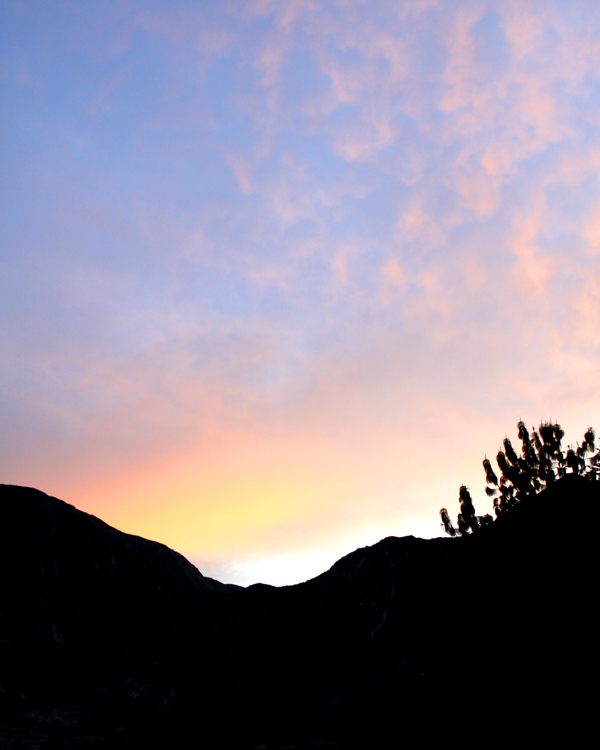 connecting flight to Quito, and spend just over a week birding the heck out of Ecuador. Unfortunately, when we checked in we found that our flight to Miami was delayed, the ONLY flight at JFK delayed on a sunny autumn morning (we later found out that our plane was delayed because American Airlines apparently forgot they needed a plane and therefore had to fly an empty one from London to fly us to Miami). It was obvious we would never make our connecting flight so four of my traveling companions switched to a later AA flight from Miami to Quito and three of us had to switch to a LAN flight that departed Miami a bit earlier than the second AA flight.
connecting flight to Quito, and spend just over a week birding the heck out of Ecuador. Unfortunately, when we checked in we found that our flight to Miami was delayed, the ONLY flight at JFK delayed on a sunny autumn morning (we later found out that our plane was delayed because American Airlines apparently forgot they needed a plane and therefore had to fly an empty one from London to fly us to Miami). It was obvious we would never make our connecting flight so four of my traveling companions switched to a later AA flight from Miami to Quito and three of us had to switch to a LAN flight that departed Miami a bit earlier than the second AA flight.
After a mad scramble at Miami’s monstrosity of an airport when AA insisted we go to their rebooking desk even though we had already rebooked, only to be given what we were told were boarding passes for our LAN flight but turned out not to be boarding passes, which we only discovered when we reached security for the terminal that we had to speedwalk for what felt like hours to get to, we were forced to cut the entire line at LAN’s counter to get actual boarding passes. The folks with LAN were extremely helpful and they let us know that they did not think our luggage would get on to the LAN flight. We made it to our plane with minutes to spare and settled in, buckled up, and readied ourselves for Quito…where our plane never landed because of runway debris that our pilot was apparently too impatient to wait to be cleared. We instead landed in Guayaquil and were given boarding passes for a flight back to Quito that would not take off for another couple of hours.
When we finally arrived in Quito the three of us on the LAN flight searched in vain for our luggage for half-an-hour and then had to wait for another half-an-hour before the undermanned baggage claim desk finally was ready to fill out our lost luggage forms. When we finally emerged through customs, sans luggage and at least eight hours after we were supposed to have arrived, we were ready to curl up into the fetal position and cry. And I almost did cry with relief when I saw our fellow Queens birders and Renato waiting for us. The hour-long drive to Pululahua Hostal went by quickly, though the dirt road down into the crater was quite the adventure, an adventure that we would get used to over the next week.
***START READING AGAIN BELOW IF YOU SKIPPED THE AIRLINE HORROR STORY***
So, anyway, I woke up at Pululahua Hostal way too early the next morning and lay there in my bed with that confused feeling one gets when one wakes up in a place one does not recognize. Then I heard a chip note and I didn’t recognize that either. I had to investigate! Within five minutes I was up, had clothes and optics on, and was out the door. And oh my goodness what the heck is that?!?!
Black-tailed Trainbearer Lesbia victoriae (above and below)
And that little bird in the bushes there, what is that? A sparrow? And, holy cow! Some kind of dove! That yellow bird there, what is that? And over there, on top of that tree, is that some kind of siskin? That dark bird over there looks like a thrush…and so on and so forth. Once Renato provided me with some coffee I grew even more frenzied but rapidly ran out of birds in the immediate vicinity of the hostal. Fortunately, several other folks were up by that point and we mounted an expedition on foot up the road.
Rufous-collared Sparrow Zonotrichia capensis, a very common bird around Pululahua
But before I continue I should probably explain where, exactly, Pululahua is and what it is like. Pululahua is an extinct volcano. Pululahua Hostal sits at the bottom of the extinct volcano’s caldera, which means that one can spin around in a circle and see the crater rim for the full 360 degrees. It is a very cool place to be based, even allowing for the forty-minute drive on a rough dirt road to get from the hostal to the nearest paved road. Pululahua is located north of Quito and, like Quito, is in a dry, inter-Andean valley which means that there is not much rain, it is way up there, and, Great Audubon’s Ghost it is cool!
The dusty dirt road that runs across the bottom of the volcanic caldera that is Pululahua and past Pululahua Hsotal is pretty good for birds. At least it seemed that way to me, busy adding lifer after lifer to my burgeoning checklist. Cool birds too, like Cinereous Conebill and Tufted Tit-Tyrant. But the birds that stole the show, at least for me, were the Golden-rumped Euphonias. Since my trip Honduras in February of 2009 I have had a soft spot for euphonias and Euphonia cyanocephala is one heck of an example. We watched several males and a couple of females feed, preen, and just be euphonias. What a bird!
male Golden-rumped Euphonia Euphonia cyanocephala
Of course the euphonias weren’t the only pretty bird that featured a right shade of yellow. There were Hooded Siskins and Southern Yellow Grosbeaks* as well, the latter a bird with a shade of yellow that puts our Yellow Warbler to shame. See for yourself in the so-so picture** below:
Southern Yellow Grosbeak Pheucticus chrysogaster
Of course, there were more birds that we saw as well, to say nothing of the birds we found up near the rim of the caldera in the late morning after breakfast. Walking near Pululahua Hostal was a great way to slowly work into the vast numbers of new-to-me birds that we would encounter on our trip. It is a beautiful setting and a marvelous place to bird.
…
*Southern Yellow Grosbeak Pheucticus chrysogaster is also known as Golden-bellied Grosbeak. I prefer the former.
**Having lost my luggage I had no tripod and therefore no way to digiscope. This means that my pictures are hardly up to my usual high standards (no snickering allowed).

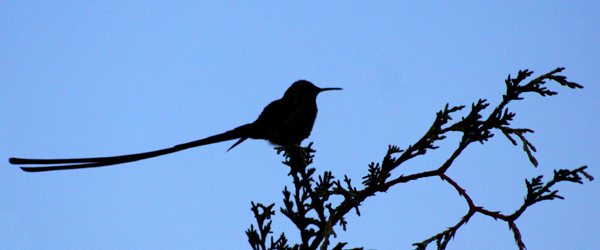
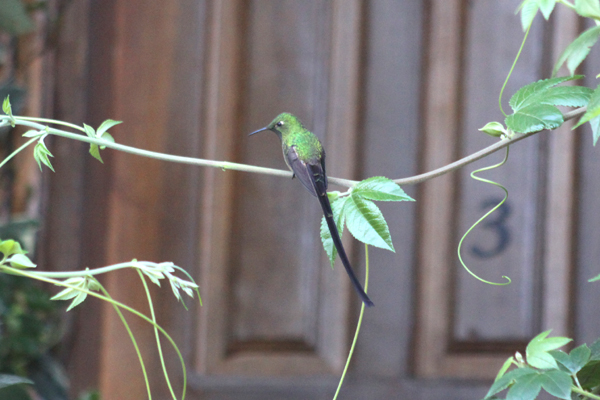
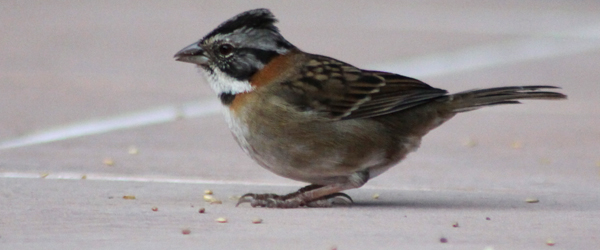
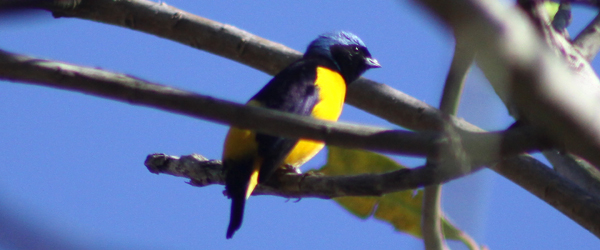
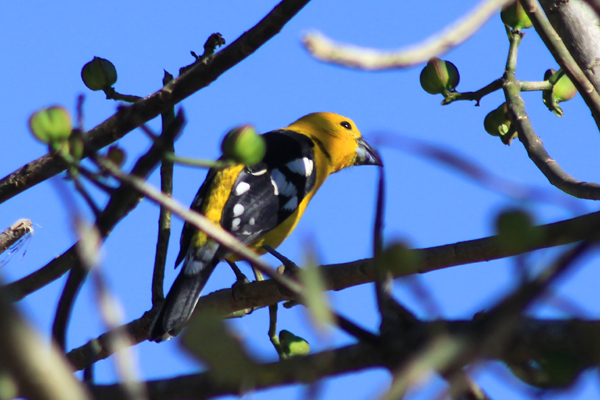










Birds are sweeter when you have to work for them, even if that work is sweat and anxiety and fury. (I put this on FB, but wanted to repeat it.)
Isn’t that Black-taled Trainbearer incredible! Ian and I saw one in the middle of Quito, in the park near the hotel. Of course, we were told not to bring our cameras to the park because of the “crime” (the park turned out to be full of soccer players and families). So, we are going back to get our Trainbearer photos.
My bags were lost for 3 days in Guayaquil once and I had to go back and forth to the airport each day to see if they’d come in. It was terrible…though I did some good birding from the little back patio at the Guayaquil. I remember seeing Saffrom Finches and Snowy-throated Kingbirds from back there!
@Donna: You definitely need to go back. What a great bird!
@Nick: Guayaquil may be a charming place but our hostal and friends awaited us in Quito…maybe someday I will go back and explore southern Ecuador!
I’ve definitely had this problem in Quito! I try to carry everything on the plane because of this problem (I know I’m the annoying passenger). Glad you made it though with camera and I must say, amazing photos!
The luggage problem is why birders should only chose to visit locations that have an attractive game reserve or some birding area near their international airport. I never would have gotten to really appreciate Namibia’s Daan Viljoen game reserve close to Windhoek without my luggage ending up in Hongkong…
Oh, and yeah, those are some nice photos of birds as well.
@YourBirdOasis and Jochen: You two are too nice…thanks!